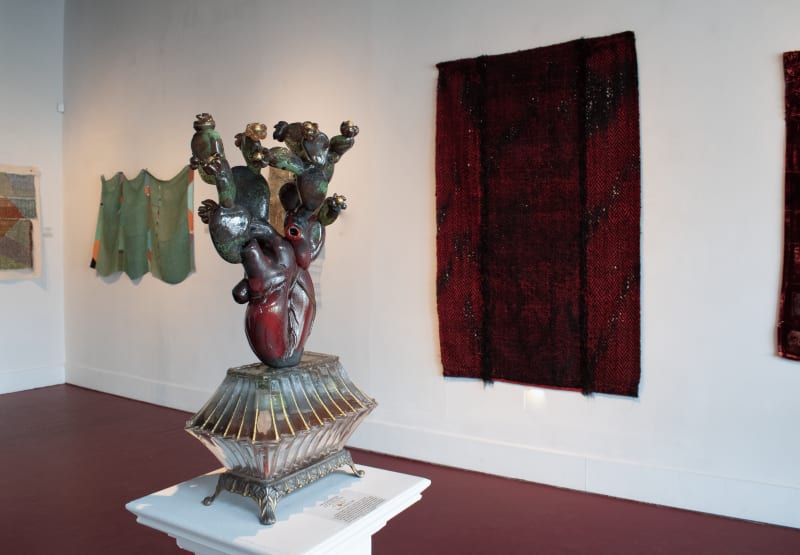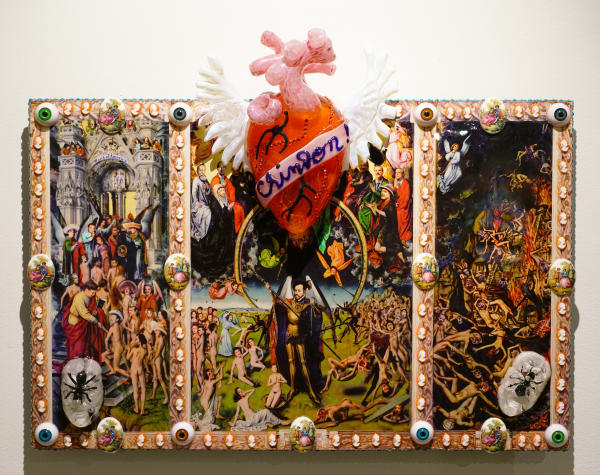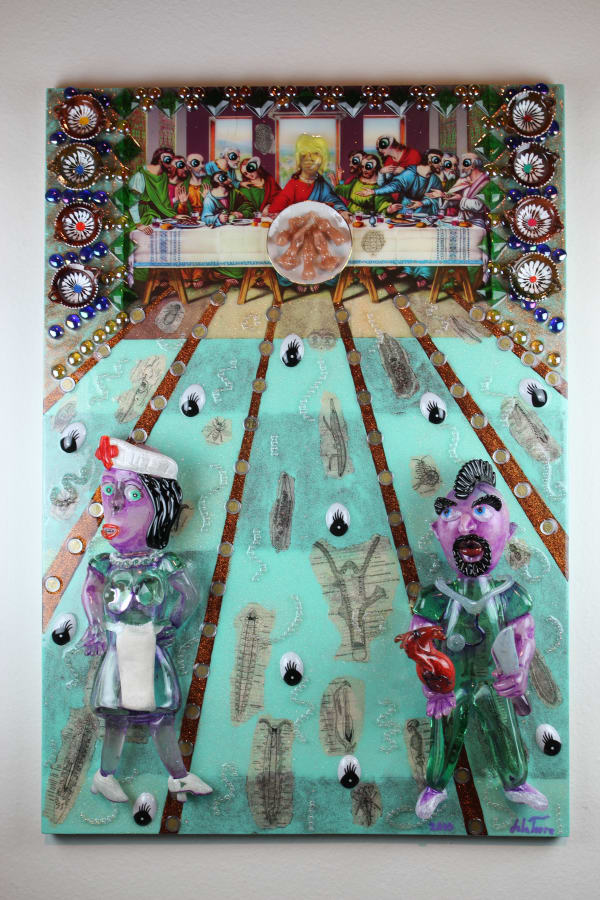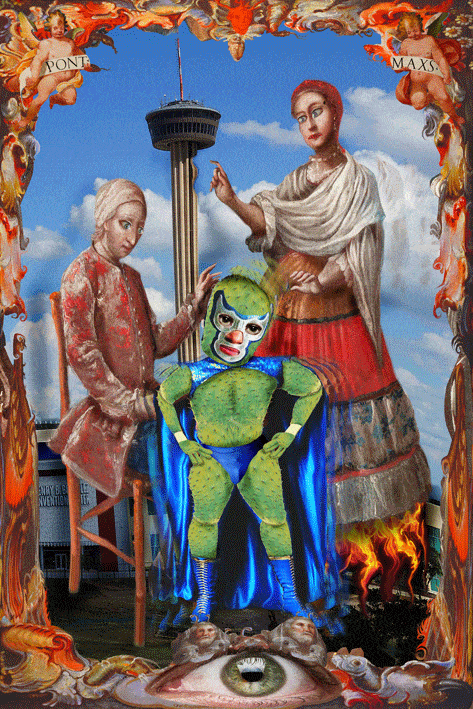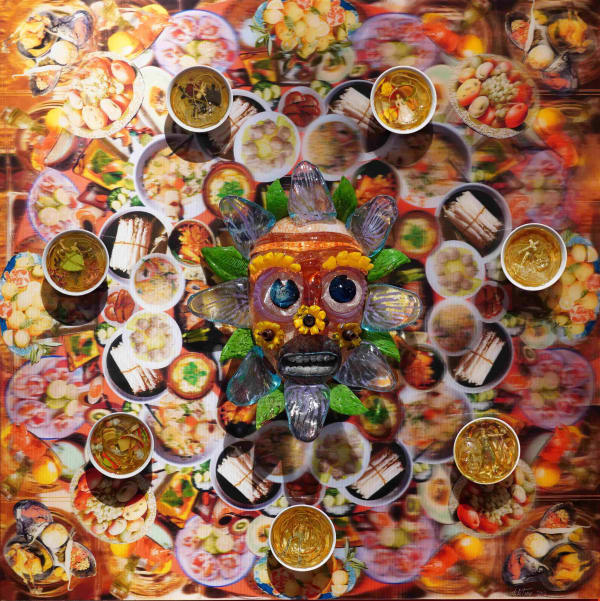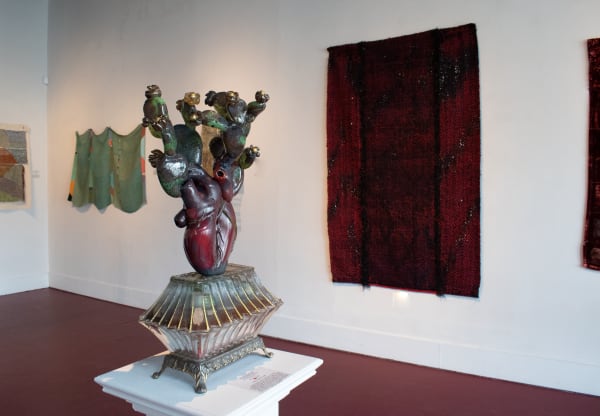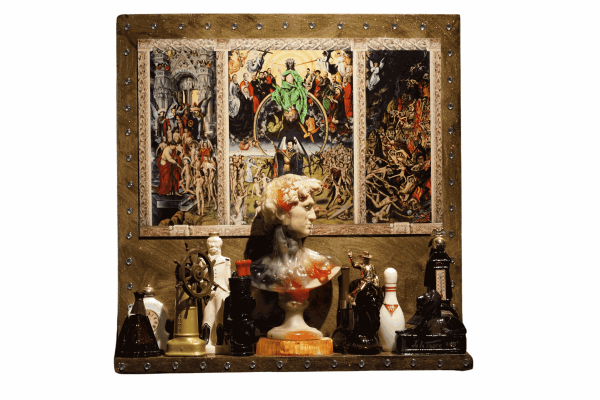Threading Glass
Ruiz-Healy Art is pleased to present Threading Glass: Consuelo Jimenez Underwood and Einar and Jamex de la Torre, on view at our San Antonio gallery from April 9th to May 31st, 2025, with an opening reception held on Wednesday, April 9th, from 6:00 to 8:00 PM attended by the artists. Threading Glass unfolds the reimagining of centuries-old craft traditions through a contemporary art lens, blending tradition with innovation. Artists Consuelo Jimenez Underwood and the de la Torre Brothers utilize history and personal experiences to create narratives that tackle multiculturalism, Latino heritage, and artisanship. This collection of works stimulates a dialogue between the tactile nature of both their practices, utilizing the rigid forms of glass and the flowing forms of tapestries as a vessel for social critique and a reaffirmation of craftsmanship as art.
Consuelo Jimenez Underwood grew up as a child of migrant farm workers, a Huichol father, and a Chicana mother, spending her childhood moving back and forth across the United States-Mexico border. Borderland life catalyzed Underwood to question the viability of border politics and the arbitrary lines that thrust a wedge into her ancestral home. The artist champions craftsmanship typically relegated to domestic settings, breathing new life and power into traditional weaving. Jimenez Underwood questions artistic canonical processes, elevating the stories and lives of marginalized migrant workers and Indigenous people through the use of weaving techniques and repurposed materials such as barbed wire, safety pins, and yellow caution tape. Green Hills was the first weaving Jimenez Underwood created after moving to Cupertino, California, where the rolling opulent green landscape surrounded her and her family’s new household, a stark contrast from the metropolis of San Diego, their former home. The artist states, “I wanted the viewer to experience 'flight’ as I often did in my lucid dreams, soaring over the hills, in the valleys, (borders) where humans made their marks, you could stop and rest…often there appeared fences, like scars torn into the green flesh of the Earth.”
Drawing from her tri-cultural background - Chicana, Indigenous, and American - the artist skillfully combines Aztec codices and Mexican iconography, weaving narratives of spirituality, social awareness, and physicality. The exhibition features her work, Father, Son, and Holy Rebozo, in which the artist reimagines the Catholic tradition of the Holy Trinity of Father, Son, and Holy Spirit. Laura E. Perez, in the book Consuelo Jimenez Underwood: Art, Weaving, Vision, states the following about the work, “Jimenez Underwood’s wicked sense of humor fuels her iconographic synthesis of these figures into specific hats worn by men. She represents the “Father” with a cowboy hat, its exterior shape formed by a repeated chain stitch overlaid upon a woven ground that contains an additional raised depiction of the border intertwined with barbed wire. The artist follows the Christian hierarchy by placing the cowboy hat in the upper register and a baseball cap, its form again outlined with a chain stitch and placed on top of a raised woven border, in the register to stand for “Son.” The Holy Spirit, because “He” is ghostly, appears without form in the lower register, indicated with a section of open work weaving using shiny metallic and thicker cotton thread in various muted greens, blues, and lavenders. The artist interrogates and questions the construction of masculinity, the association of maleness with divinity, and the erasure of women and femaleness from positions of power and authority in the imagination of organized religions.”
Einar and Jamex de la Torre are an artist duo born in Guadalajara, Mexico, who moved to Southern California as adolescents and have collaborated since the 1990s. The de la Torre brothers use a mixed-media process that includes glass-blowing, resin castings of carefully chosen objects, lenticular pieces, and large-scale installations. They craft baroque, theatrical scenes and characters that invoke humorous, multi-layered critiques of political figures, contemporary consumerism, and social stratification. These humorous critiques are evident in the work Letting Them Eat Cake, in which a glass pig is placed on top of a silver platter, holding out a slice of vanilla cake, reaching out to the viewer in a Marie Antoinette fashion. The work nods to the dark underbelly of decadence, wealth, and status, scorning contemporary powers and their priority of revenue at the expense of others.
The de la Torre brothers combine aspects of American popular culture, “the absurd pageantry of Catholicism and machismo” in Mexico, and materialism and overconsumption. Their work is an ongoing reflection of the mestizo experience, a cultural mix where stories, traditions, and aesthetics collide. In conjunction with their campy, maximalist style and satirical commentary, they pay homage to their polyculture heritage through references to Mexican vernacular arts, pre-Columbian art, religious iconography, and German expressionism. Through their ultra-Baroque multicultural work, irony and humor are essential tools to initially engage an audience but ultimately showcase social critiques, not just within one group but populations of affluent countries. The Latin Exoskeleton series is a collection of lenticular artworks that unravel the ongoing conversation of what it means to be “Latinx.” The artists do this by dissecting and appropriating Casta (caste) paintings, which were prominent in colonial Mexico, and used to depict the social hierarchy and evolving lineage of 18th-century society. A Nopalero character dressed in a luchador uniform takes center stage in Nopalero de las Americas. The Nopalero’s skin mimics the coarse surface of a nopal cactus, alluding to the idea that coming from a diverse background encourages one to develop a strong exterior, challenging the negative undertones Casta (caste) paintings often present.
The lenticular’s background also features the Tower of the Americas in San Antonio, Texas, an iconic symbol of the city and a nod to the multiplicity of cultures that call San Antonio home.
Carefully chosen objects such as Jimenez Underwood’s safety pins and the de la Torre’s silver trays carry layered meanings. Hybrid forms throughout the exhibition juxtapose sacred and profane imagery, pre-Columbian symbolism, and cultural references. From sparkling decadence to soft folk textiles, Threading Glass is an expression of reverence for the overlap of art and craft that embodies the content, form, and philosophy of the artist’s choice of medium to explore hybrid cultural themes and communication across real and imagined borders.
-
 Consuelo Jimenez UnderwoodResistencia Yaqui, 1992Loom woven in three panels. Painted, mixed media. Linen, cotton, synthetic threads. Paper, textile paint, leather barbed wire72 x 46 in
Consuelo Jimenez UnderwoodResistencia Yaqui, 1992Loom woven in three panels. Painted, mixed media. Linen, cotton, synthetic threads. Paper, textile paint, leather barbed wire72 x 46 in
182.9 x 116.8 cm -
 Consuelo Jimenez UnderwoodUndocumented Nopal. 2525 AD, 2019Stitched, woven, embroidered, and silkscreened. Silk and cotton fabric. Linen, Kentucky barbed wire, cotton, and synthetic thread70 x 48 in
Consuelo Jimenez UnderwoodUndocumented Nopal. 2525 AD, 2019Stitched, woven, embroidered, and silkscreened. Silk and cotton fabric. Linen, Kentucky barbed wire, cotton, and synthetic thread70 x 48 in
177.8 x 121.9 cm -
 Consuelo Jimenez UnderwoodAmerican Dress. Virgen de Tepin (Chili), 1999Stitched, silkscreened, painted, embroidered. Silk velvet, gold wire, barbed wire, textile paint56 x 34 in
Consuelo Jimenez UnderwoodAmerican Dress. Virgen de Tepin (Chili), 1999Stitched, silkscreened, painted, embroidered. Silk velvet, gold wire, barbed wire, textile paint56 x 34 in
142.2 x 86.4 cm -
 Einar and Jamex de la TorreChingon!, 2017Blown glass and mixed media18 x 24 x 5 in
Einar and Jamex de la TorreChingon!, 2017Blown glass and mixed media18 x 24 x 5 in
45.7 x 61 x 12.7 cm -
 Einar and Jamex de la TorreE.R. for the Soul, 2010Blown glass and mixed media41 x 28 x 8 in
Einar and Jamex de la TorreE.R. for the Soul, 2010Blown glass and mixed media41 x 28 x 8 in
104.1 x 71.1 x 20.3 cm -
 Einar and Jamex de la TorreEau de David, 2014Cast resin, mixed media and silver print27.5 x 26.75 x 6.25 in
Einar and Jamex de la TorreEau de David, 2014Cast resin, mixed media and silver print27.5 x 26.75 x 6.25 in
69.8 x 67.9 x 15.9 cm -
 Consuelo Jimenez UnderwoodStrawberry Pickers: Half Moon Bay, CA 2020, 2022Loom woven in three panels, wire, linen, cotton, and metallic threads41 x 65 in
Consuelo Jimenez UnderwoodStrawberry Pickers: Half Moon Bay, CA 2020, 2022Loom woven in three panels, wire, linen, cotton, and metallic threads41 x 65 in
104.1 x 165.1 cm -
 Consuelo Jimenez UnderwoodFather, Son and Holy Rebozo, 2017Woven wire, linen, metallic and cotton thread40 x 19 in
Consuelo Jimenez UnderwoodFather, Son and Holy Rebozo, 2017Woven wire, linen, metallic and cotton thread40 x 19 in
101.6 x 48.3 cm -
 Consuelo Jimenez UnderwoodGreen Hills, 1985Woven dyed linen and nylon thread, green steel wire38 x 60 in
Consuelo Jimenez UnderwoodGreen Hills, 1985Woven dyed linen and nylon thread, green steel wire38 x 60 in
96.5 x 152.4 cm -
 Einar and Jamex de la TorreCorazon Nopalero, 2023Blown glass and mixed media25 x 15 x 9 in
Einar and Jamex de la TorreCorazon Nopalero, 2023Blown glass and mixed media25 x 15 x 9 in
63.5 x 38.1 x 22.9 cm -
 Einar and Jamex de la TorreLetting them Eat Cake, 2023Blown glass and mixed media15 x 12 x 15 in
Einar and Jamex de la TorreLetting them Eat Cake, 2023Blown glass and mixed media15 x 12 x 15 in
38.1 x 30.5 x 38.1 cm -
 Einar and Jamex de la TorreGame Warden, 2023Blown glass and resin21 x 15.5 x 10 in
Einar and Jamex de la TorreGame Warden, 2023Blown glass and resin21 x 15.5 x 10 in
53.3 x 39.4 x 25.4 cm -
 Einar and Jamex de la TorreMixed Company, 2012Cast resin and mixed media19 x 10 x 4 in
Einar and Jamex de la TorreMixed Company, 2012Cast resin and mixed media19 x 10 x 4 in
45.7 x 22.9 x 10.2 cm -
 Einar and Jamex de la TorreNapoleon Complex, 2023Resin and mixed media29 x 18 x 1.5 in
Einar and Jamex de la TorreNapoleon Complex, 2023Resin and mixed media29 x 18 x 1.5 in
73.7 x 45.7 x 3.8 cm -
 Einar and Jamex de la TorreNopalero de las Americas, 2023Archival pigmented lenticular print, LED panel43.5 x 32 x 2.25 in
Einar and Jamex de la TorreNopalero de las Americas, 2023Archival pigmented lenticular print, LED panel43.5 x 32 x 2.25 in
110.5 x 81.3 x 5.7 cm -
 Einar and Jamex de la TorreNopalero, 2023Blown glass and mixed media27.5 x 12 x 12 in
Einar and Jamex de la TorreNopalero, 2023Blown glass and mixed media27.5 x 12 x 12 in
69.8 x 30.5 x 30.5 cm -
 Einar and Jamex de la TorreSmakelijk, 2013Archival pigmented lenticular print, blown glass, and mixed media40 x 40 x 6 in
Einar and Jamex de la TorreSmakelijk, 2013Archival pigmented lenticular print, blown glass, and mixed media40 x 40 x 6 in
101.6 x 101.6 x 15.2 cm -
 Einar and Jamex de la TorreVirgen Nopalera, 2023Blown glass and mixed media20 x 11 x 9 in
Einar and Jamex de la TorreVirgen Nopalera, 2023Blown glass and mixed media20 x 11 x 9 in
50.8 x 27.9 x 22.9 cm
-
 Installation Images by Yadira Silva
Installation Images by Yadira Silva -
 Installation Images by Yadira Silva
Installation Images by Yadira Silva -
 Installation Images by Yadira Silva
Installation Images by Yadira Silva -
 Installation Images by Yadira Silva
Installation Images by Yadira Silva
-
 Installation Images by Yadira Silva
Installation Images by Yadira Silva -
 Installation Images by Yadira Silva
Installation Images by Yadira Silva -
 Installation Images by Yadira Silva
Installation Images by Yadira Silva -
 Installation Images by Yadira Silva
Installation Images by Yadira Silva

